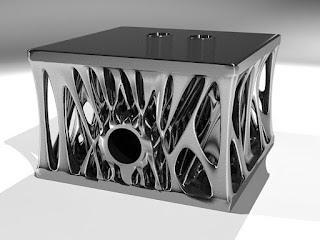Art & Design
Technology
The New Art of Creation
Today, I was listening to an amazing guest-speaker talk by Carl Bass (ex-CEO of Autodesk) in Vivek's Exponential Innovation class, and he mentioned that Autodesk has a software that does “Generative
Design”. I thought what he shared was really cool and decided to do a mini follow-up research on that. Here's my consolidated findings from the past hour.
What is “Generative Design”?
Have you ever wondered why an object you see
looks the way it does? Look at a typical image of a chair for example. For many
years in human history, it looks like the following image. Even after hearing
bed time stories of Goldilocks breaking a baby bear’s chair when she sits on
it, the design generally remains.
This is because humans tend to design and
create things that are proven to work. The design may change slightly to look
more aesthetic pleasing, but in order to serve the functionality of the object,
most designers generally do not deviate from the tested-and-proven method.
Generative design changes this notion. The
beginning point of a design no longer starts from a pre-conceived design by the
designer. It begins with the end goals the designer wants to attain (i.e.
lighter with lesser materials, or stronger with lesser weak joints that cause
breakage), and then it lets the computer do the rest of the calculation work
and design improvements till the final product is created.
The process is iterative like the diagram
below:
The end result is that the computer will create the final design which serves the goal that is required.
This design method is especially exciting now
because technology has reached a stage where computational power is cheap, and
machine learning algorithms can enable the computer to produce lots of design output to choose from that is hard to design from scratch.
A more interesting observation is that the computer design output without human intervention somehow ended up looking organic, similar to the creations of mother nature
after millions of years of evolution.
Here are some use cases from Autodesk
Use Case 1: Airbus manufacturer trims the weight
of its A320 plane to reduce carbon footprint by manufacturing light-weight
partitions with the help of Generative Design technologies.
Use Case 2: Hack Rod pioneered a new manufacturing
revolution for racing cars by using Generative Design, Virtual Reality, and 3D
printing.
You can use generative design to design perpetually
anything that needs to be manufactured. Pretty cool isn’t it?
On one hand I am really amazed by the technology, on the other I can't help but also think about the disruption that this will bring.
In the manufacturing industry, we no longer have to rely on legacy moulds that have not changed for years due to design constraints. The computer simply works out something that can be built, and we can proceed to 3D print it, knowing that it is going to be faster, cheaper, stronger and lighter. Designers no longer have to design boring parts and pieces from scratch. Their job role changes to a more problem solving role, working alongside with powerful computers to help them perform more complex calculations. In fact, the generated design output could give them new ideas to create something even more mind blowing that no one today has seen before.
We now live in a world filled with exponential changes. What does this mean for our next generation? On one hand we should embrace the wonders of technology, on the other we also need to watch out for the societal impacts that follow, especially if jobs are going to be replaced by robots faster than humans can be trained to work alongside with technology.
Changes will come no matter what. It is not going to be easy, but our generation will need to be figuring this out.
Sources:


















No comments